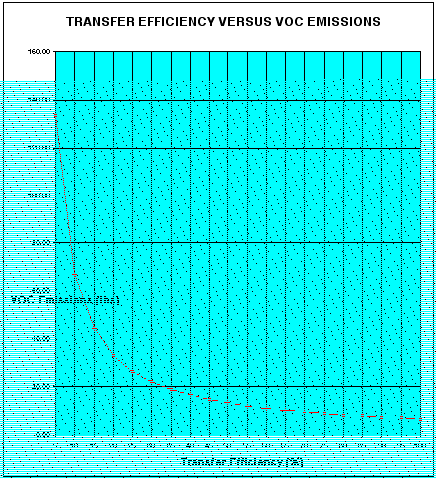 *1
*1TRANSFER EFFICIENCY
By Ron Joseph of Ron Joseph & Associates, Inc.
Transfer efficiency is expressed as a simple ratio:
Transfer Efficiency = Wt. of solid coating deposited on part (lbs) Wt. of solid coating used during the application (lbs)
Weight of solid coating used during the application (g) is the amount of solid coating that is issued from the spray gun or other application device during the process. Since the application device uses liquid rather than solid coating, this value can be calculated from the following equation:
Wt. of Solid coating (g) = (Wt. liquid coating x Wt. Solids [%])/100It is relatively easy to determine the weight of solid coating deposited and weight of liquid coating used. However, to determine the percent weight of solids in the coating, a laboratory analysis must be performed. The analysis is simple to carry out, but the results of a transfer efficiency calculation are extremely sensitive to the accuracy of the laboratory analysis. In fact, it is critical that the laboratory analysis be performed on the exact same coating that is used during the transfer efficiency test. It is strongly recommended that the vendor's literature on percent weight solids not be used! Even a small error between the vendor's value and the laboratory analysis can result in an erroneous transfer efficiency calculation!
Factors that Effect Transfer Efficiency
Of all the strategies available for reducing pollution (air, water and waste) and costs from a paint facility, transfer efficiency probably provides the most benefits.
Several factors affect transfer efficiency to a smaller or greater extent. These include:
For electrostatic guns additional parameters include:
Sensitivity of Transfer Efficiency to VOC/HAP Emissions, Hazardous Waste and Costs
The relationship between transfer efficiency and VOC/HAP emissions, disposal of hazardous waste or costs is shown by Figure 1. While the x-axis is in terms of percent efficiency, the y-axis can be calculated in terms of environmental benefits or costs. The shape of the curve remains the same.
As will be noted by referring to Figure 1, when the transfer efficiency is low, a small improvement in efficiency will yield a significant emission reduction benefit. For instance, by improving efficiency from, say 10% to 15%, reductions of VOC emissions of 33% will result. (Refer to Table I for actual values) Low transfer efficiencies in the 10-15% range are not unusual when painting small parts, and very little effort is required to make improvements which can shift the transfer efficiency by 5 percentage points. The cost savings will be somewhat higher, because they include reduced purchases of coatings and solvents, less liquid and solid waste, less spray booth maintenance, and lower emission permit fees.
As the transfer efficiency approaches the higher end of the range, a small improvement in transfer efficiency will produce only a nominal emission reduction. For instance, when painting large machines, transfer efficiencies in the 60-75% range are realistic. A 5 percentage point improvement will yield an emission reduction of approximately 7%, and cost savings will be somewhat higher.
Spray Guns and Transfer Efficiency
There is a general misconception in industry that HVLP or electrostatic spray guns automatically yield high transfer efficiencies. Because of the wording that has been used in many air pollution regulations, there is a general belief that HVLP and electrostatic spray guns yield transfer efficiencies in excess of 65%. This is incorrect!
It is true that HVLP and electrostatic spray guns, when properly used, are more efficient than conventional air atomizing spray guns, but their improved efficiency has no relation whatever to the 65% value that is often quoted in regulations and vendor literature.
For example, if a properly operating conventional air atomizing spray gun used to apply coating to a set of small parts yields a transfer efficiency of say 5%, then an HVLP or electrostatic spray gun might produce a slightly higher efficiency, say 7 - 10%, but not much higher than that.
On the other hand, if all three spray guns are properly used to apply coating to a large surface, then all three devices can be expected to yield relatively high transfer efficiencies, perhaps even greater than the mystical 65%. The HVLP and electrostatic guns will probably yield slightly higher results than those for the conventional air atomizing spray done.
By far the most important parameters for maximizing transfer efficiency are in the hands of painting operators. An operator using a conventional air atomizing spray gun who has been properly trained and uses efficient painting techniques will be far more effective in improving transfer efficiency than an operator who uses an HVLP or electrostatic spray gun, but has not been trained in proper painting practices.
 *1
*1
*1 Percent Reduction is calculated on a volume solids basis. One cannot calculate percent reduction by simply subtracting the two transfer efficiency values and expressing them as a percentage on the first value. In the Appendix we provide the equation which is used.
NOTE: The equation for calculating % Reduction is as follows:
% Reduction = (E2 - E1) x 100 E2
Where:
E1 = (VOC x 100) / (1 - VOC/D)x %TE1
VOC = VOC content of the coating expressed in (lbs/gal)
E1 = Emissions of VOC expressed as (lbs VOC/gal of coating solids as applied to the job)
D = Density of the VOC, expressed in (lbs/gal). Note that if you do not know the density of the VOC, EPA will allow you to use a default value of 7.36 lbs/gal.
%TE1 = Transfer efficiency of the coating application #1, expressed as a percentage and not as a fraction. If you prefer to use TE as a fraction, then eliminate the "100" in the numerator of the equation.

Back to finishing.com Home Page ![]()